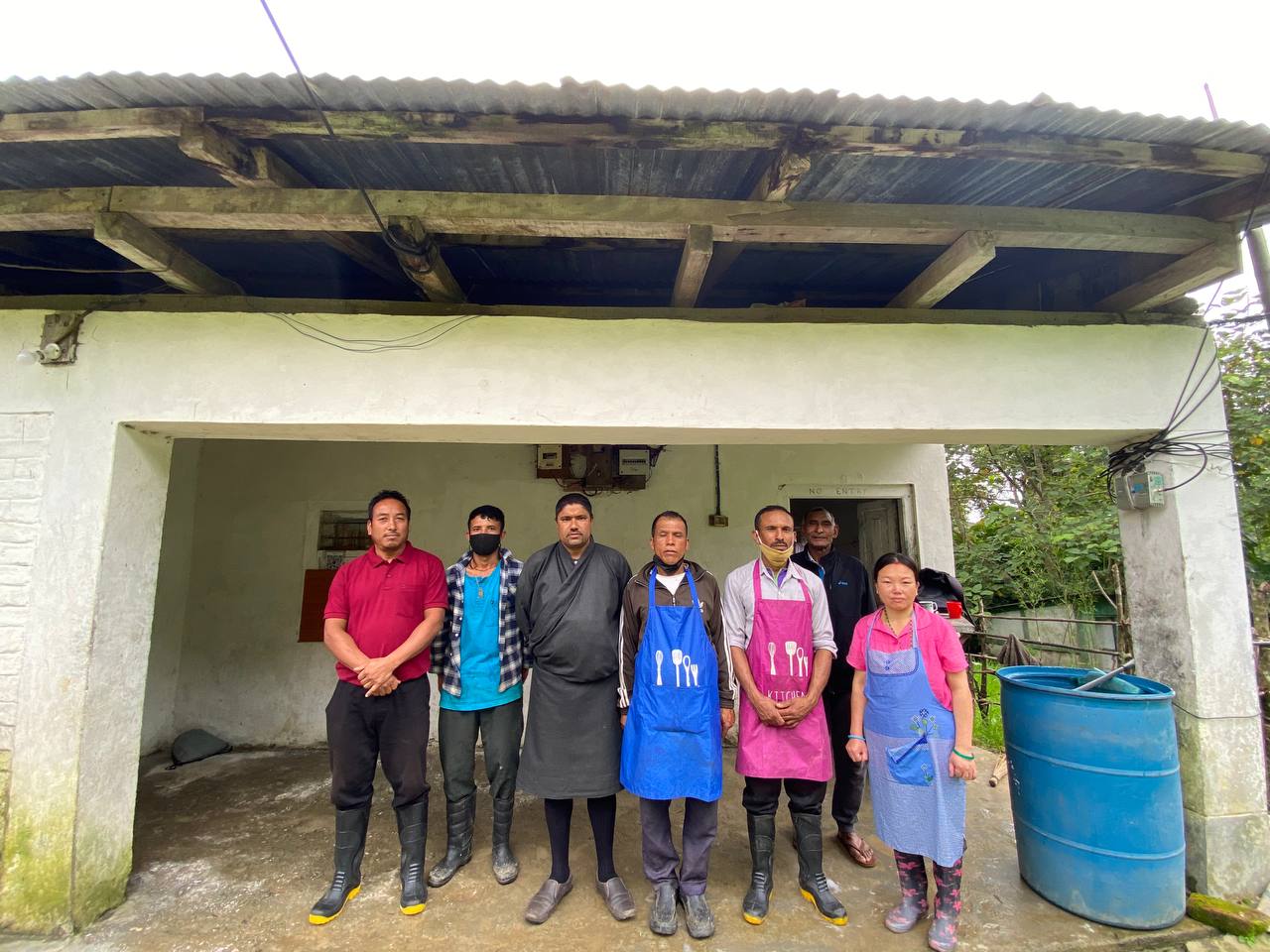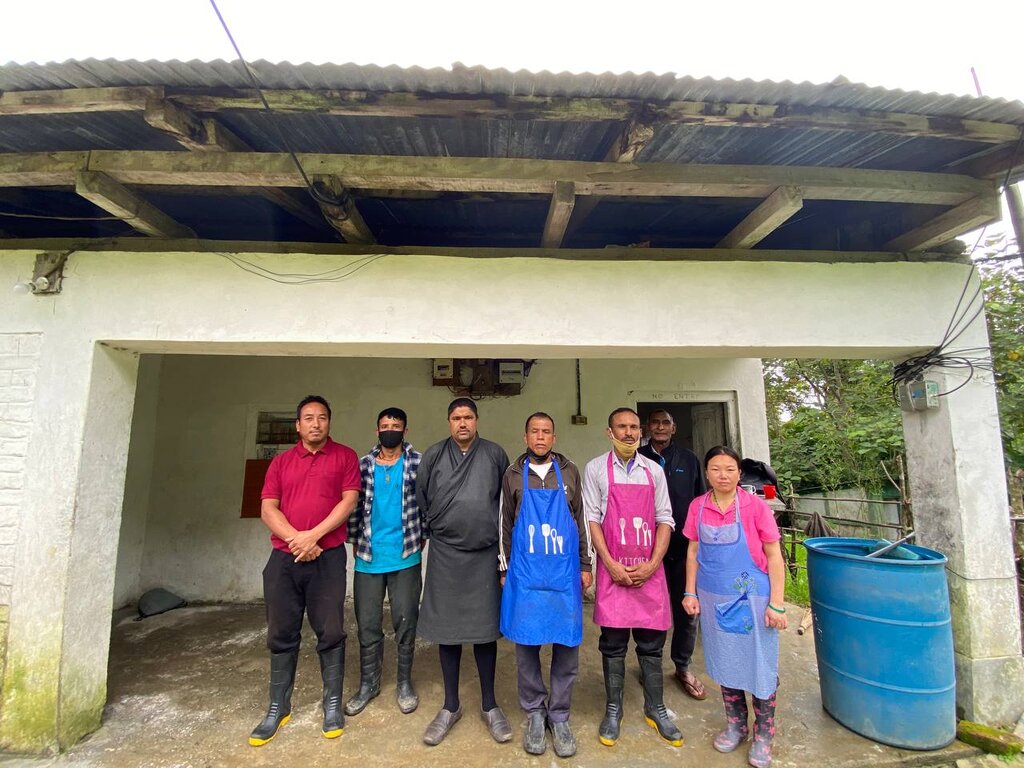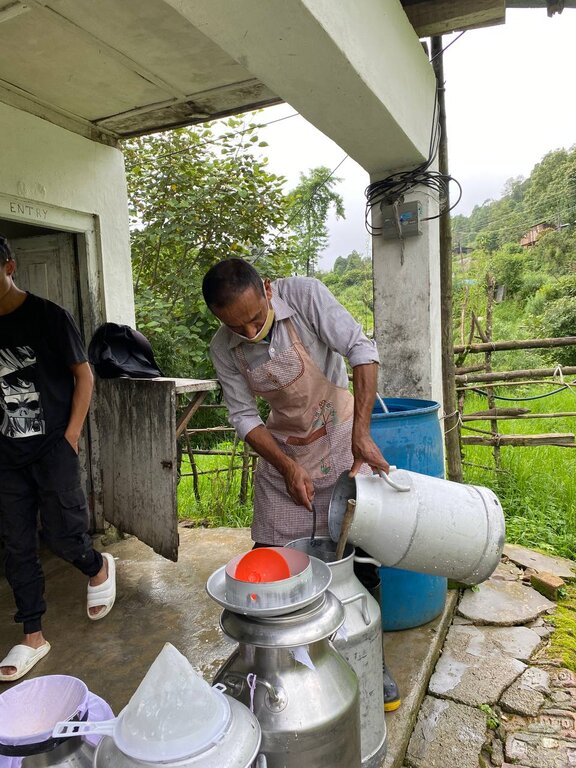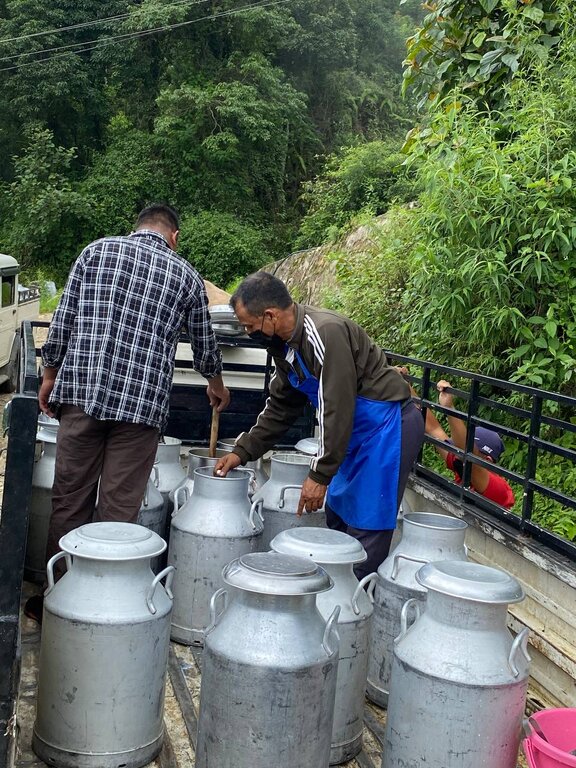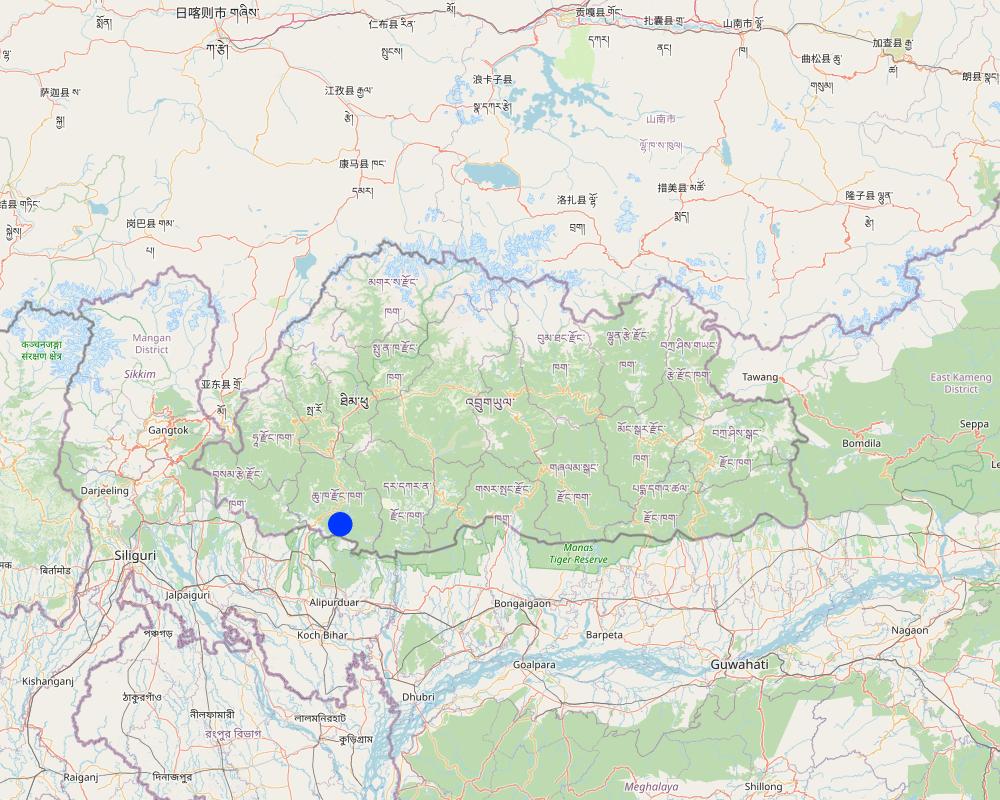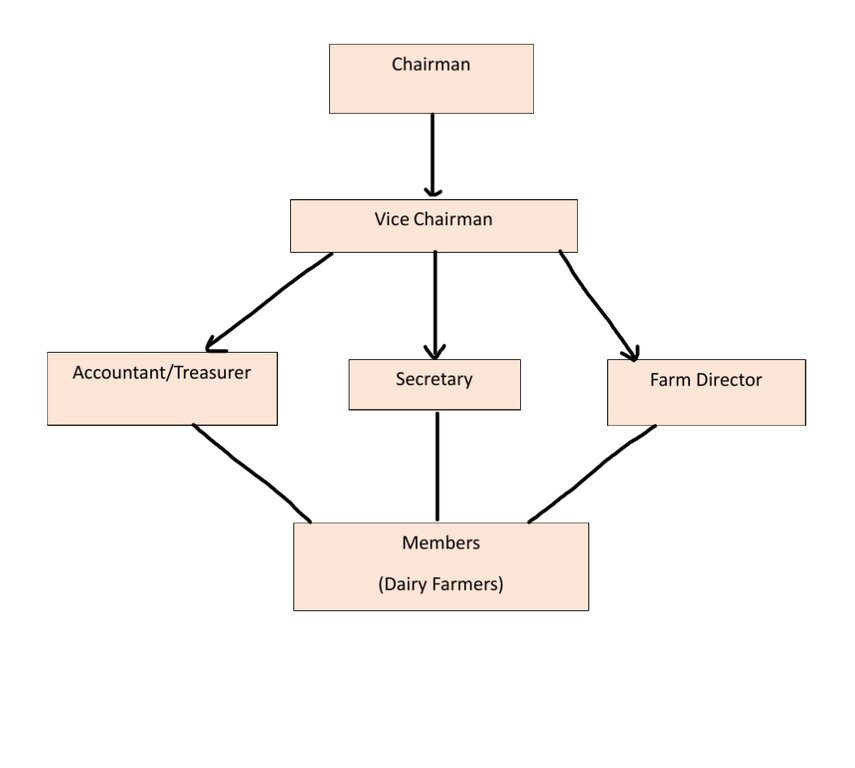Darla Dairy Cooperative [Bhutan]
- Creation:
- Update:
- Compiler: Karma Wangdi
- Editor: chenga Tshering
- Reviewers: William Critchley, Rima Mekdaschi Studer
Gonor Nyamley Detshen (སྒོ་ནོར་མཉམ་ལས་སྡེ་ཚན།)
approaches_6868 - Bhutan
View sections
Expand all Collapse all1. General information
1.2 Contact details of resource persons and institutions involved in the assessment and documentation of the Approach
Key resource person(s)
land user:
Samal Bal Kumar
17720749
Darla, Chukha Dzongkhag (District)
Bhutan
land user:
Gurung Pancha Maya
16931238
Darla Dairy Cooperative
Darla, Chukha Dzongkhag (District)
Bhutan
land user:
Chettri Datta Singh
16911283
Darla Dairy Cooperative
Darla, Chukha Dzongkhag (District)
Bhutan
land user:
Basnet Chandra Kumar
17810553
Darla Dairy Cooperative
Darla, Chukha Dzongkhag (District)
Bhutan
land user:
Kharki Ram
17480128
Darla Dairy Cooperative
Darla, Chukha Dzongkhag (District)
Bhutan
Name of project which facilitated the documentation/ evaluation of the Approach (if relevant)
Strengthening national-level institutional and professional capacities of country Parties towards enhanced UNCCD monitoring and reporting – GEF 7 EA Umbrella II (GEF 7 UNCCD Enabling Activities_Umbrella II)Name of the institution(s) which facilitated the documentation/ evaluation of the Approach (if relevant)
National Soil Services Centre, Department of Agriculture, Ministry of Agriculture & Livestock (NSSC) - Bhutan1.3 Conditions regarding the use of data documented through WOCAT
When were the data compiled (in the field)?
17/07/2023
The compiler and key resource person(s) accept the conditions regarding the use of data documented through WOCAT:
Yes
2. Description of the SLM Approach
2.1 Short description of the Approach
The Darla dairy cooperative is an example of where farmers come together to form collective organizations for production, collection, transportation, processing, and marketing of milk and dairy products. These are business models operated as member-owned and member-controlled organizations.
2.2 Detailed description of the Approach
Detailed description of the Approach:
Livestock in Bhutan are reared for a multitude of purposes, encompassing the production of milk, food, and dung, as well as serving as a means of generating draught power, generating revenue, and accumulating assets. Dairy products, particularly butter and cheese, occupy significant significance within the Bhutanese nutritional framework and have emerged as a noteworthy economic resource for certain households in recent times. Knowing its importance many Bhutanese farmers are forming the cooperative groups. One thing that has been constantly growing over the years in Darla Gewog under Chhukha Dzongkhag is a Farmer’s Cooperative.
Darla dairy cooperatives are business owned and operated by dairy farmers, designed to collectively manage market milk and dairy products (Singh & Gupta, 2015). One of their main features is the collective ownership structure, where farmers become members and actively participate in decision-making processes. By pooling resources, dairy cooperatives enable farmers to access shared facilities, such as milk processing plants and storage, reducing individual cost and enhancing efficiency. Additionally, they offer fair and transparent pricing mechanisms, ensuring farmers receive a competitive price for their milk. Dairy cooperatives also provide valuable technical assistant, training, and access to markets, supporting farmer's growth and sustainability in the dairy industry (USDA, 2015).
The aims and objectives of dairy cooperatives revolve around empowering dairy farmers and promoting their collective welfare. One of the primary objectives is to facilitate shared ownership and democratic decision-making, allowing farmers to collectively manage their dairy operation. Another key aim is to ensure fair and equitable distribution of profits among members, promoting economic sustainability and social development within the dairy community. Dairy cooperatives also strive to provide access to modern technologies empowering farmers with the knowledge and skill needed for sustainable dairy farming practices (FAO, 2019).
The formation of a dairy cooperative typically involves several methods and steps to ensure successful establishment. Firstly, a core group of dairy farmers with common goals come together to initiate the cooperative. They conduct meetings, gauge interest, and identify potential members. Once the core group is established, they create formal bylaws that outline the cooperative's objectives, membership criteria, decision-making processes and profit-sharing mechanisms. To attract more members, awareness campaigns and informational sessions organized by gewog livestock extension agents showcase the benefits of joining the cooperatives. Financial planning and livestock management efforts are also undertaken to raise the necessary capital for initial investments, such as setting up milk processing facilities and infrastructures. There are 101 registered dairy farmers who contribute milk through the cooperative. The dairy cooperative is operated by 6 core members who manage the daily activities.
Dairy cooperatives play a crucial role in the dairy industry by bringing together various stakeholders and facilitating their collaboration. The primary stakeholders involved in dairy cooperative includes dairy farmers who are the core members and owner of the cooperative. They actively participate in decision-making and contribute their milk to the cooperative for processing and marketing. Additionally, consumers are significant stakeholders as they rely on dairy cooperatives to provide them with high quality milk and dairy product. Other stakeholders like the gewog livestock extension agent, the District livestock officer and other officials are involved in a meeting which is conducted twice a year. Marketing opportunities are the main driving forces for producers to produce more of any type of product. Identification of market opportunities and the development of proper marketing strategies for milk and milk products for selected groups of villages would be a useful approach to support dairy cooperatives.
2.3 Photos of the Approach
2.5 Country/ region/ locations where the Approach has been applied
Country:
Bhutan
Region/ State/ Province:
Chukha
Further specification of location:
Darla
Map
×2.6 Dates of initiation and termination of the Approach
Indicate year of initiation:
2014
If precise year is not known, indicate approximate date when the Approach was initiated:
less than 10 years ago (recently)
2.7 Type of Approach
- recent local initiative/ innovative
2.8 Main aims/ objectives of the Approach
The dairy cooperative aims to increase income through marketing of surplus milk, by engaging unemployed youths. Such intervention is expected to address problem srelated to rural urban migration.
2.9 Conditions enabling or hindering implementation of the Technology/ Technologies applied under the Approach
availability/ access to financial resources and services
- enabling
Priority support is given to the group and cooperatives in terms of investment and financial support by the government.
collaboration/ coordination of actors
- enabling
Dairy cooperative enables farmers' to access and shared facilities, by pooling resources
markets (to purchase inputs, sell products) and prices
- enabling
Increasing demand for milk and dairy products motivate farmers' to raise more dairy cattle and increase production
workload, availability of manpower
- enabling
Enabled sharing of workload equitabily
3. Participation and roles of stakeholders involved
3.1 Stakeholders involved in the Approach and their roles
- local land users/ local communities
Dairy farmers
Actively participate in decision-making and, produce and supply milk to the cooperative for processing and marketing as specified in the bylaw
- local government
Livestock Extension Agent
Provide technical supports (health, feed and fodder, breeding and management) and monitor the progress of cooperative
- national government (planners, decision-makers)
District Livestock Officer
Royal audit authority
Assist in prioritization of issues and planning
Mobilize human and financial resources
Monitor and ensure adequate financial supports
3.2 Involvement of local land users/ local communities in the different phases of the Approach
| Involvement of local land users/ local communities | Specify who was involved and describe activities | |
|---|---|---|
| initiation/ motivation | interactive | The core dairy farmers with guidance from the Gewog Livestock Extension Agent came up with ideas to establish a dairy cooperative/group. |
| planning | interactive | Core members along with intellectual people from the village assisted by gewog livestock extension agent planned and proposed. |
| implementation | interactive | Interested dairy farmers supported by the gewog livestock agent and dzongkhag implemented the activity following the workplan and bylaws agreed upon. |
| monitoring/ evaluation | external support | The activities of the dairy cooperatives are monitored periodically through field visit, monthly report, Bi-annual general assembly meeting and annual audit. |
3.3 Flow chart (if available)
Description:
Presented flow chart of Darla Dairy cooperatives with engagement of all the members
Author:
Terms of Reference of Darla Dairy Cooperatives
3.4 Decision-making on the selection of SLM Technology/ Technologies
Specify who decided on the selection of the Technology/ Technologies to be implemented:
- land users alone (self-initiative)
Explain:
The idea was conceptualized by the core group members, and accordingly planned and dairy cooperative was established initially. The engagement of other stakeholders came after the establishment.
Specify on what basis decisions were made:
- personal experience and opinions (undocumented)
4. Technical support, capacity building, and knowledge management
4.1 Capacity building/ training
Was training provided to land users/ other stakeholders?
Yes
Specify who was trained:
- land users
Form of training:
- on-the-job
Subjects covered:
Group mobilization, bookkeeping , planning
Hygienic and clean milk production, collection, transportation, and processing.
Breeding and management (AI, Housing, feeding system)
Comments:
The specialized training was provided by subject matter specialist, and on basic topic by the respective Extension Agent
4.2 Advisory service
Do land users have access to an advisory service?
Yes
Specify whether advisory service is provided:
- on land users' fields
Describe/ comments:
Officials from NCOA Yusipang monitored their work, and livestock officials organized awareness program on the management, care, prevention and control of common cattle diseases
4.3 Institution strengthening (organizational development)
Have institutions been established or strengthened through the Approach?
- yes, moderately
Specify the level(s) at which institutions have been strengthened or established:
- local
Describe institution, roles and responsibilities, members, etc.
The number of dairy cooperative members have increased by 15 households.
Specify type of support:
- equipment
Give further details:
All members of the cooperative were supplied with milk cans to collect, store and transport milk
4.4 Monitoring and evaluation
Is monitoring and evaluation part of the Approach?
Yes
Comments:
Physical on site monitoring and evaluating the quality, standard, cleanliness of the work and products
If yes, is this documentation intended to be used for monitoring and evaluation?
No
4.5 Research
Was research part of the Approach?
No
5. Financing and external material support
5.1 Annual budget for the SLM component of the Approach
If precise annual budget is not known, indicate range:
- 10,000-100,000
Comments (e.g. main sources of funding/ major donors):
The approach was implemented with the seed money collected from the members.
5.2 Financial/ material support provided to land users
Did land users receive financial/ material support for implementing the Technology/ Technologies?
Yes
If yes, specify type(s) of support, conditions, and provider(s):
They were provided with the milk processing equipment
5.3 Subsidies for specific inputs (including labour)
- agricultural
| Specify which inputs were subsidised | To which extent | Specify subsidies |
|---|---|---|
| Machines | fully financed | -Chunning machine -Office furnitures - cream separator -analyzer -yogurt incubator -deep freezer and fridge |
Comments:
The government fully funded construction of milk processing, and is being operated by the cooperative free of cost.
5.4 Credit
Was credit provided under the Approach for SLM activities?
No
5.5 Other incentives or instruments
Were other incentives or instruments used to promote implementation of SLM Technologies?
No
6. Impact analysis and concluding statements
6.1 Impacts of the Approach
Did the Approach empower local land users, improve stakeholder participation?
- No
- Yes, little
- Yes, moderately
- Yes, greatly
They got more recognition and support
Did the Approach enable evidence-based decision-making?
- No
- Yes, little
- Yes, moderately
- Yes, greatly
future plans are drawn based on the needs, issues and challages faced during the operation of dairy cooperative
Did the Approach build/ strengthen institutions, collaboration between stakeholders?
- No
- Yes, little
- Yes, moderately
- Yes, greatly
Physical and financial support received have enhanced, improved social cohesion
Did the Approach improve gender equality and empower women and girls?
- No
- Yes, little
- Yes, moderately
- Yes, greatly
Every men and women is given equal right.
Did the Approach lead to improved food security/ improved nutrition?
- No
- Yes, little
- Yes, moderately
- Yes, greatly
Increased milk and dairy products and excess dairy products are processed and supplied to schools, hospitals and other markets.
Did the Approach improve access to markets?
- No
- Yes, little
- Yes, moderately
- Yes, greatly
Formalized group marketing, and the quality of milk products have improved
Did the Approach lead to employment, income opportunities?
- No
- Yes, little
- Yes, moderately
- Yes, greatly
Some school drop-outs and laid-off youths are employed in collecting and transportation of milk.
6.2 Main motivation of land users to implement SLM
- increased profit(ability), improved cost-benefit-ratio
Member earn an average gross monthly income between Nu. 30000-40000
- payments/ subsidies
Government provide subsidies (materials support) for the construction of improved dairy shed
- affiliation to movement/ project/ group/ networks
Their products are marketed within the gewog, and excess products are marketed to other districts
6.3 Sustainability of Approach activities
Can the land users sustain what has been implemented through the Approach (without external support)?
- yes
If yes, describe how:
The initial investment has been recovered, and current income meets the operation cost.
6.4 Strengths/ advantages of the Approach
| Strengths/ advantages/ opportunities in the land user’s view |
|---|
| Source of cash income |
| Increased cooperation and network |
| improve household livelihood |
| Strengths/ advantages/ opportunities in the compiler’s or other key resource person’s view |
|---|
| Creates employment opportunities to the school drop-outs and rural youths |
| Contributes to food security and better nutrition |
6.5 Weaknesses/ disadvantages of the Approach and ways of overcoming them
| Weaknesses/ disadvantages/ risks in the land user’s view | How can they be overcome? |
|---|---|
| Scattered settlement and production | Increase the number of transportation vehicles, improve road connectivity |
| Short shelf life of milk | Try marketing in nearby places if possible, install cold chain facilities |
| Delay in payment | Create a terms of agreement with the retailers to ensure payment on time |
| Weaknesses/ disadvantages/ risks in the compiler’s or other key resource person’s view | How can they be overcome? |
|---|---|
| No proper market outlet for wholesale marketing | explore market outside gewog |
7. References and links
7.1 Methods/ sources of information
- field visits, field surveys
5
- interviews with land users
5
7.3 Links to relevant information which is available online
Title/ description:
Cooperatives in the Dairy Industry
URL:
https://www.google.com/url?sa=t&source=web&rct=j&opi=89978449&url=https://www.rd.usda.gov/files/cir1-16.pdf&ved=2ahUKEwi9z4b8-Z6AAxV7umMGHQsgBZUQFnoECBMQAQ&usg=AOvVaw0jmrAUETNEh8crEba04qjj
Title/ description:
Dairy development through cooperative structure
URL:
https://www.fao.org/3/T3080T/t3080T0a.htm
Title/ description:
Analysis of knowledge and adoption level of the dairy farmers regarding clean milk production (CMP) practices
URL:
https://www.indianjournals.com/ijor.aspx?target=ijor:jdfhs&volume=34&issue=3&article=002
Links and modules
Expand all Collapse allLinks
No links
Modules
No modules


